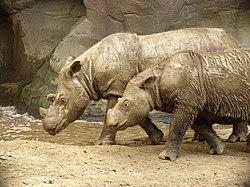Sumatran Rhino
| Sumatran rhinoceros | |
|---|---|
 |
|
| Sumatran rhinoceroses Emi and Harapan in the Cincinnati Zoo | |
| Scientific classification | |
| Kingdom: | Animalia |
| Phylum: | Chordata |
| Class: | Mammalia |
| Order: | Perissodactyla |
| Family: | Rhinocerotidae |
| Genus: |
Dicerorhinus Gloger, 1841 |
| Species: | D. sumatrensis |
| Binomial name | |
|
Dicerorhinus sumatrensis (Fischer, 1814)  |
|
| Subspecies | |
|
|
 |
 |
 |
 |
| Clockwise from top left: Mallotus, mangosteens, Ardisia, and Eugenia. | |
| Sumatran rhinoceros vocalizations (.wav files) |
|
|---|---|
The Sumatran rhinoceros, also known as the hairy rhinoceros or Asian two-horned rhinoceros (Dicerorhinus sumatrensis), is a rare member of the family Rhinocerotidae and one of five extant rhinoceroses. It is the only extant species of the genus Dicerorhinus. It is the smallest rhinoceros, although it is still a large mammal; it stands 112–145 cm (3.67–4.76 ft) high at the shoulder, with a head-and-body length of 2.36–3.18 m (7.7–10.4 ft) and a tail of 35–70 cm (14–28 in). The weight is reported to range from 500 to 1,000 kg (1,100 to 2,200 lb), averaging 700–800 kg (1,500–1,800 lb), although there is a single record of a 2,000 kg (4,400 lb) specimen. Like both African species, it has two horns; the larger is the nasal horn, typically 15–25 cm (5.9–9.8 in), while the other horn is typically a stub. A coat of reddish-brown hair covers most of the Sumatran rhino's body.
Members of the species once inhabited rainforests, swamps, and cloud forests in India, Bhutan, Bangladesh, Myanmar, Laos, Thailand, Malaysia, Indonesia, and China. In historical times, they lived in southwest China, particularly in Sichuan. They are now critically endangered, with only five substantial populations in the wild: four on Sumatra and one on Borneo. Their numbers are difficult to determine because they are solitary animals that are widely scattered across their range, but they are estimated to number fewer than 100. Survival of the Peninsular Malaysia population is in doubt, and one of the Sumatran populations may already be extinct. In 2015, researchers announced that the Bornean rhinoceros had become extinct from the northern part of Borneo (Sabah, Malaysia); however, a tiny population was discovered in East Kalimantan in early 2016.
The Sumatran rhino is a mostly solitary animal except for courtship and offspring-rearing. It is the most vocal rhino species and also communicates through marking soil with its feet, twisting saplings into patterns, and leaving excrement. The species is much better studied than the similarly reclusive Javan rhinoceros, in part because of a program that brought 40 Sumatran rhinos into captivity with the goal of preserving the species. There was little or no information about procedures that would assist in ex situ breeding. Though a number of rhinos died once at the various destinations and no offspring were produced for nearly 20 years, the rhinos were all doomed in their soon to be logged forest. In March 2016, a Sumatran rhinoceros was spotted in Indonesian Borneo.
...
Wikipedia

